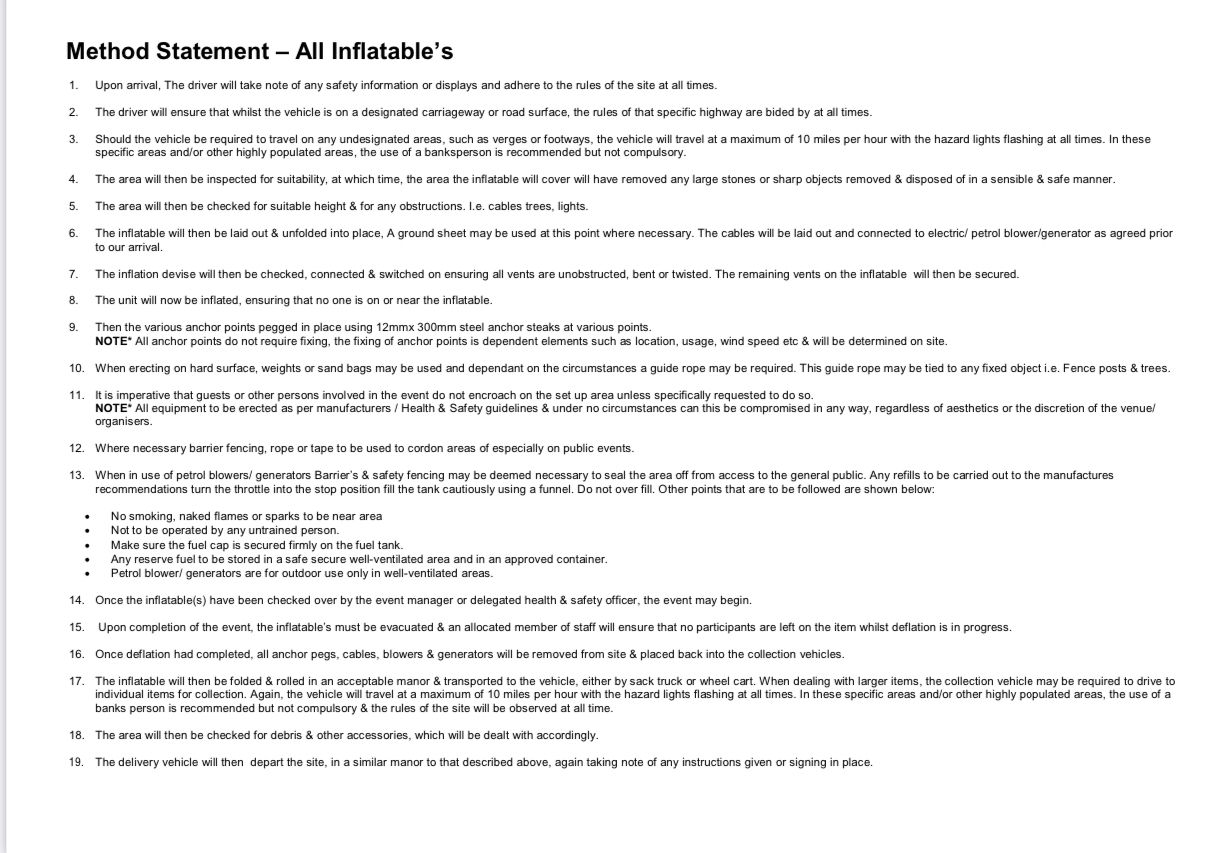Risk Assessments
Bouncy Castle Hire Equipment Risk Assessment
1. Introduction:
• Objective: To identify and mitigate potential risks associated with the operation and use of bouncy castle hire equipment.
2. Hazard Identification:
• 2.1 Inflatables Setup:
• Risk: Uneven or unstable ground during setup.
• Mitigation: Conduct thorough site inspections, secure anchors, and choose level ground.
• 2.2 Weather Conditions:
• Risk: Adverse weather conditions (wind, rain).
• Mitigation: Monitor weather forecasts, deflate during high winds or rain.
• 2.3 User Behavior:
• Risk: Unsafe behaviour, overcrowding, or rough play.
• Mitigation: Provide clear usage guidelines, supervise events, and limit the number of users.
• 2.4 Equipment Maintenance:
• Risk: Damaged or poorly maintained equipment.
• Mitigation: Regular inspections, maintenance checks, and timely repairs.
3. User Guidelines:
• 3.1 Age and Size Restrictions:
• Clearly communicate age and size restrictions for users.
• 3.2 Footwear:
• Prohibit shoes, sharp objects, or accessories inside the inflatable.
• 3.3 Maximum Capacity:
• Specify the maximum number of users allowed at a given time.
4. Emergency Preparedness:
• 4.1 First Aid:
• Ensure a designated first aid area and personnel are available.
• 4.2 Emergency Evacuation:
• Establish and communicate evacuation procedures.
5. Supervision:
• 5.1 Trained Operators:
• Assign trained operators to monitor usage.
• 5.2 User Briefing:
• Provide users with safety guidelines and rules before allowing entry.
6. Communication:
• 6.1 Event Organizers:
• Maintain open communication between event organizers and bouncy castle operators.
• 6.2 Emergency Contacts:
• Display emergency contact information prominently.
7. Post-Event Procedures:
• 7.1 Equipment Deflation:
• Ensure safe and controlled deflation procedures.
• 7.2 Inspection:
• Conduct post-event inspections for damages and cleanliness.
8. Documentation:
• 8.1 Incident Reporting:
• Establish a protocol for reporting and documenting any incidents.
• 8.2 Regular Audits:
• Schedule periodic risk assessments and equipment audits.
9. Review and Update:
• 9.1 Regular Review:
• Periodically review and update the risk assessment based on experiences and industry standards.
10. Conclusion:
• This risk assessment aims to provide a framework for safe bouncy castle hire equipment operation. Regularly review and update procedures to ensure ongoing safety compliance.
Method Statement

Electrical Equipment for Personal Hire - Safety Assurance
1. Introduction:
• Objective: Ensuring the safety of users during personal hire by implementing an annual Portable Appliance Testing (PAT) certification for all electrical equipment.
2. Hazard Identification:
• 2.1 Equipment Reliability:
• Despite annual PAT testing, there may be a risk of equipment malfunction.
• Mitigation: Users are encouraged to conduct regular visual inspections and report any concerns promptly.
3. User Guidelines:
• 3.1 Familiarization:
• Users are provided with guidance on the proper handling and safe operation of electrical equipment.
• 3.2 Safety Gear Emphasis:
• Emphasize the importance of wearing appropriate safety gear during equipment use.
4. Emergency Preparedness:
• 4.1 First Aid Awareness:
• Users are informed about the location of first aid resources.
• 4.2 Emergency Response:
• Clear communication of emergency shut-off procedures is provided.
5. Supervision:
• 5.1 User Responsibility:
• Users are encouraged to operate electrical equipment responsibly.
• 5.2 Awareness:
• Users are advised to be vigilant and report any irregularities during equipment operation.
6. Communication:
• 6.1 Usage Instructions:
• Clear usage instructions and safety guidelines are provided with each equipment rental.
• 6.2 Reporting Mechanism:
• Users are urged to report any observed issues or malfunctions promptly.
7. Inspection and Maintenance:
• 7.1 Visual Checks:
• Users are prompted to perform regular visual checks for visible damage or wear.
• 7.2 Maintenance Reminder:
• Remind users of the importance of reporting any signs of wear or damage for prompt attention.
8. Documentation:
• 8.1 Incident Reporting:
• A user-friendly incident reporting protocol is established.
• 8.2 User Records:
• Encourage users to keep a record of visual checks and reported incidents.
9. Review and Update:
• 9.1 User Feedback:
• Periodically seek user feedback to improve safety measures.
• 9.2 Annual Review:
• Conduct an annual review of safety procedures and update guidelines based on user experiences.
10. Conclusion:
• This safety assurance plan highlights our commitment to user safety during personal electrical equipment hire. Annual PAT certifications and user cooperation contribute to a secure and enjoyable experience